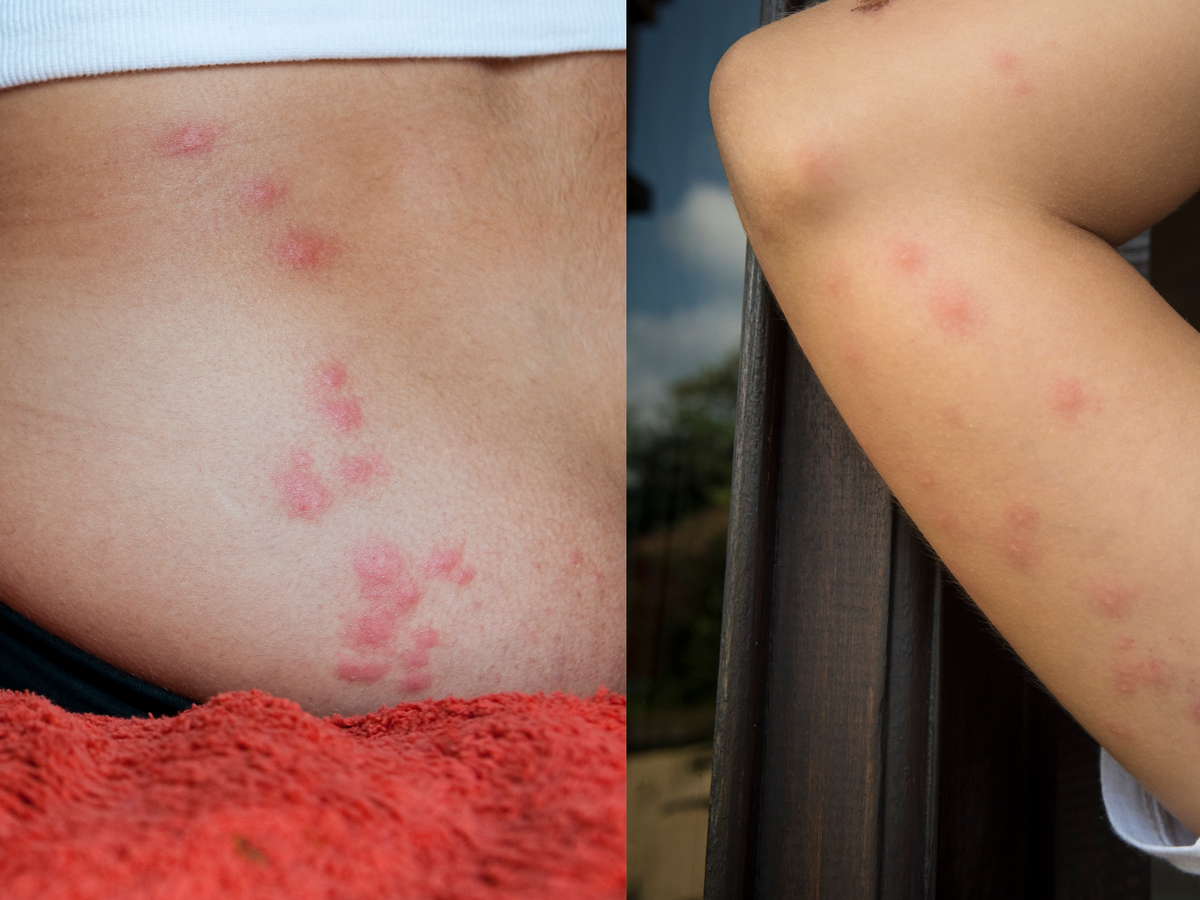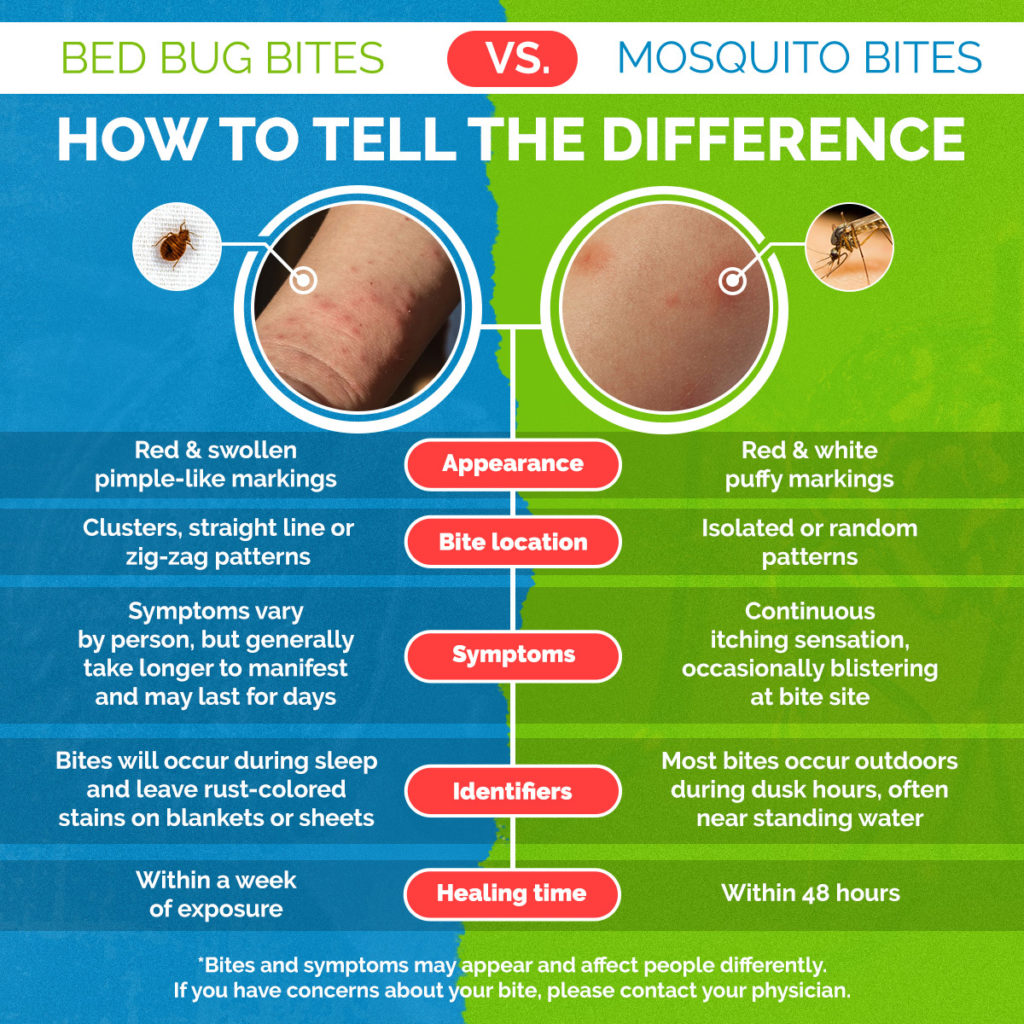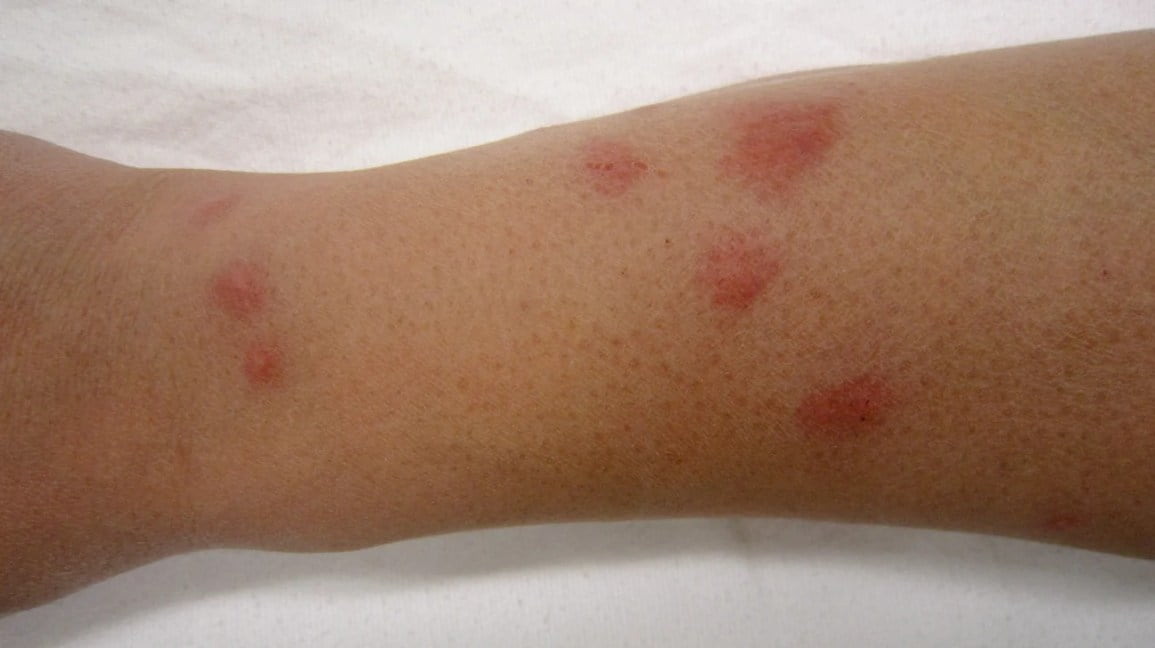To identify bed bug bites, look for red and swollen marks with a dark center. These bites may appear in lines or clusters and can be itchy, burning, or fluid-filled blisters.
You may also find blood stains on your sheets from scratching. Bed bugs are a common household pest that can cause significant discomfort and damage. It’s essential to identify the signs of bed bugs early on to prevent a full-blown infestation.
While bed bugs can be challenging to spot, their bites are often the first sign of their presence. We’ll discuss how to recognize bed bug bites, how to distinguish them from other insect bites, and what to do if you suspect you have bed bugs. We’ll also answer some frequently asked questions about bed bug bites, including how long they last and how to check yourself for bed bugs.

Credit: www.prevention.com
Signs Of Bed Bug Bites
If you’re experiencing itchiness, burning, or a cluster of bites, you may have bed bugs. Learning to identify bed bug bites is crucial in detecting an infestation early and seeking treatment to eradicate the pests. Other indicators of bed bugs are bloodstains on sheets and actual sightings of the insects.
What Do Bed Bug Bites Look Like?
Bed bug bites are typically red and swollen with a dark spot in the center that sometimes resembles hives or welts. They can be blurry and irregularly shaped or lined up in clusters. Fluid-filled blisters are also symptoms of bed bug bites.
Itchiness And Burning
The hallmark symptom of bed bug bites is itchiness and burning, which can occur immediately but may take some time to manifest. Scratching bed bug bites can result in skin damage and possible infection. If you experience burning and itchy sensations, it’s best to avoid scratching and seek medical attention.
Clusters Of Bites
Bed bugs tend to bite repeatedly, resulting in a telltale pattern of clustered bites on areas of the body that are exposed during sleep. Most commonly, bites appear on the arms, legs, neck, and face. If you notice itchy bumps in groups or lines, it’s highly possible that bed bugs are present.
Blood Stains On Sheets
Bed bugs feed on human blood and will leave behind bloodstains on bedding, mattresses, and clothing. Noticing bloody specks or streaks on your sheets and pillowcases, particularly after having slept in the same bed for several nights, may be a sign of a bed bug infestation.
To sum up, bed bug bites can look like welts or hives and symptoms include itchiness, burning, or fluid-filled blisters, clustered bites on areas exposed while sleeping and bloodstains on bedding or clothing. If you have any of these symptoms, seek medical attention and professional pest control services.

Credit: www.carolinapest.com
How To Know If You Have Bed Bugs
Bed bug bites can be identified as red, swollen bumps with a dark spot in the middle. They are usually found in lines or clusters, and may also appear as hives or welts. Itchy and sometimes accompanied by burning or fluid-filled blisters, bed bug bites may also leave blood stains on sheets from scratching.
To check for bed bugs, inspect areas where they typically hide, such as along seams and edges of mattresses and furniture.
In recent years, bed bug infestations have become more common around the world. These tiny pests feed on human blood, usually at night, and can leave behind itchy, red, and swollen bites. If you wake up with small bumps on your skin that are arranged in clusters or lines, it could be a bed bug bite. In this article, we’ll discuss how to know if you have bed bugs bites.Inspecting For Bed Bugs
One of the best ways to determine if you have a bed bug infestation is to inspect your home for these pests. Look for signs of bed bugs, including shed skins, fecal stains, and eggs. Check the seams, folds, and tufts of your mattress and box spring, as well as any nearby furniture or clutter. Use a flashlight to examine the areas thoroughly, and pay close attention to any dark or hidden spots. You may also want to use bed bug traps to catch any bugs that may be hiding in your bed.Recognizing Bed Bugs
If you’re not sure what bed bugs look like, it’s important to familiarize yourself with their appearance. Adult bed bugs are about the size of an apple seed and are reddish-brown in color. They are flat and oval-shaped, and their bodies swell and turn redder after feeding. Bed bug eggs are small, white, and oval-shaped, while bed bug nymphs are smaller than adults and light-colored.Preventing Bed Bug Infestations
The best way to avoid bed bug bites is to prevent an infestation from occurring in the first place. When traveling, inspect hotel rooms for bed bugs before unpacking. Wash and dry your clothes on high heat after returning from a trip. Keep clutter to a minimum in your home and regularly vacuum carpets and upholstery. If you purchase used furniture, inspect it thoroughly before bringing it inside. If you suspect a bed bug infestation, contact a pest control professional to help eliminate the problem.In conclusion, if you suspect you have bed bug bites, inspect your home for bed bugs, learn to recognize their appearance, and take steps to prevent infestations. Remember to take swift action if you suspect a bed bug infestation, as these pests can reproduce rapidly and become even harder to eliminate over time.What Kills Bed Bugs Instantly
To know if you have bed bug bites, look for red and swollen marks with a dark spot in the center. Bites may appear in lines or clusters, and can be itchy or burning. You may also find blood stains on your sheets from scratching.
Be sure to inspect for bed bugs to prevent an infestation.
What Kills Bed Bugs Instantly?When it comes to dealing with bed bugs, one of the most important aspects is finding a solution that can kill them instantly. Bed bugs can cause a lot of discomfort and inconvenience, and you want to make sure that you are dealing with them effectively. Here are some products that can help kill bed bugs instantly:Hot Shot Bedbug & Flea Fogger
This is a fogger that is designed to kill bed bugs and fleas instantly. It is easy to use, and all you have to do is set it off in the infested room. The fogger releases a mist that contains ingredients that are lethal to bed bugs and fleas. The fogger is effective in treating large areas, but you should still vacuum and clean the area thoroughly afterwards.Crossfire Bed Bug Concentrate
This is a solution that is designed to kill bed bugs instantly. It contains multiple active ingredients that attack bed bugs from different angles, which makes it more effective than single-ingredient solutions. The solution is easy to mix and use, and it can be sprayed directly onto infested areas. It is important to follow the instructions carefully when using this product.Harris Large Bed Bug Kit
This is a kit that includes multiple products that are designed to kill bed bugs instantly. It includes a bed bug killer spray, a bed bug egg killer spray, and a bed bug powder. The kit also includes a bed bug detection trap. The products are easy to use and can help you eliminate bed bugs quickly and effectively.In conclusion, these products can help you kill bed bugs instantly. However, it is important to remember that bed bug infestations can be difficult to eradicate completely. You may need to use a combination of these products and other measures, such as vacuuming and cleaning, to get rid of bed bugs for good.How Long Do Bed Bug Bites Last
Bed bug bites can last up to three to six weeks without treatment. They are red and swollen, with a dark spot at the center of each bite and may appear in lines or clusters. Bites are typically itchy, and scratching can lead to skin infection.
Untreated Bites Duration
If you have been bitten by bed bugs and do not receive any treatment, you can expect your bites to last anywhere from three to six weeks. During this time, your skin may remain swollen, itchy, and irritated, causing discomfort. This duration may also vary based on the severity of infestation. Additionally, if you continue to get bitten by bed bugs, new bites may form even as the older ones disappear.Possibility Of Infection
While bed bug bites do not generally pose a significant health threat, if you scratch your bites excessively, you increase the risk of infection. Scratching can cause the skin to break, leading to open wounds that can develop infections. If you notice pus, oozing, redness, or swelling around your bites, it is essential to seek medical attention as soon as possible. Treating bed bug bites with anti-itch creams and over-the-counter antihistamines can help alleviate the discomfort that comes with itching.In conclusion, while bed bug bites are not dangerous, they can cause discomfort and itching that can last up to six weeks. If you notice any signs of an infection, seek medical attention immediately. Additionally, taking preventative measures such as regularly cleaning your bedding and furniture can help prevent future infestations.Diagnosing And Treating Bed Bug Bites
Bed bug bites may be red, swollen and itchy, with a dark spot at the center of each bite. They can be arranged in lines or clusters and often appear as hives or welts. Blisters filled with fluid may also be present.
You may also find bloodstains on the sheets from scratching. Knowing the signs can help you diagnose and treat bed bug bites promptly.
Diagnosing and Treating Bed Bug Bites:Bed bugs are small, flat, reddish-brown insects that feed on human blood during the night. They are primarily found in places like hotels, dormitories, and apartments. If you wake up with itchy, red marks on your skin, you may have bed bug bites. In this section, we will look at how to diagnose and treat bed bug bites effectively.Looking for Two Signs:To confirm whether you have been bitten by bed bugs, look out for two signs: the bites themselves and bloodstains on your sheets. Bed bug bites usually appear as red and swollen welts, with a noticeable dark spot at the center of each bite. They often occur in a line or cluster, with multiple bites grouped together. You may also find bloodstains on the sheets, caused by accidentally scratching the bites while asleep.Bites on Your Body:If you suspect that you have bed bug bites, take a closer look at your body. Bed bug bites are typically found on exposed areas of skin, such as the face, neck, arms, and hands. They are itchy, painful, and can be very uncomfortable. If you notice any bites, clean the affected area with warm water and soap to prevent any infection. For an additional way to relieve discomfort, place a cool, damp cloth on the bites.Treatment Options:Now that we know how to diagnose bed bug bites, let’s look at the treatment options. There are several ways to treat bed bug bites, including over-the-counter medications and home remedies. Here are some effective options:– Topical creams and ointments: Applying a topical cream or ointment that contains hydrocortisone can help reduce itching, swelling, and irritation caused by the bites.– Oral antihistamines: Antihistamines are commonly used to reduce itching and relieve allergy symptoms. Taking an oral antihistamine like diphenhydramine can help you feel better.– Essential oils: Certain essential oils like peppermint, lavender, and tea tree oil have anti-inflammatory and antiseptic properties. Applying them to the affected area can help reduce itching and discomfort.If you are experiencing a severe allergic reaction or an infection, seeking medical attention is recommended. A doctor can provide prescription medication or other treatments to help alleviate the symptoms.In conclusion, it is important to recognize the signs of bed bug infestations and take proper precautions to avoid them. Knowing how to diagnose and treat bed bug bites can make a significant difference in your overall health and well-being.Credit: www.businessinsider.com
Frequently Asked Questions Of How To Know If You Have Bed Bugs Bites?
How Do You Tell If A Bite Is From A Bed Bug?
Bedbug bites appear as red and swollen with a dark spot at the center, arranged in lines or clusters, and are usually itchy and burning. Fluid-filled blisters may also develop, and bloodstains may be found on sheets. Seek medical attention if you develop an allergic reaction or infection.
How Do You Check Yourself For Bed Bugs?
To check yourself for bed bugs, inspect your bedding, mattress seams, and headboard for signs of bugs, excrement, or eggs. Look for red and swollen bites with a dark spot at the center, arranged in lines or clusters, and bloodstains on sheets.
These bites may also itch, burn, or have fluid-filled blisters. Pay attention to dark areas and crevices in your room and furniture, and consider hiring a professional exterminator if you suspect an infestation.
Can You See Bed Bugs With The Naked Eye?
Yes, bed bugs can be seen with naked eyes. However, they are small and flat, measuring about the size of an apple seed, making them difficult to spot.
How Long Do Bed Bug Bites Last?
Bed bug bites usually last for three to six weeks if left untreated. However, new bites may continue to appear as long as the infestation is present. The bites are red, swollen, and may have a dark spot in the center.
They can be arranged in lines or clusters, and feel itchy or burning. Scratching can cause further irritation and infection.
Conclusion
Identifying whether you have bed bug bites can be done by paying attention to a few key characteristics. Look out for bites that are red and swollen, with a dark spot at the center, and arranged in lines or clusters.
They may also look like a hive, welt, or blister. Remember to inspect and clean your surroundings thoroughly to prevent an infestation, and seek medical attention if necessary. With these tips, you’ll be able to detect bed bug bites and take action to keep yourself and your home safe.
Related posts:

I’m MD Tanvir, and I bring years of expertise gained from working closely with pest control companies to the forefront. My journey in the industry has inspired me to launch Bug Battler, a platform aimed at equipping people with the know-how to combat pests autonomously. Through Bug Battler, I aim to empower individuals with practical insights to tackle pest infestations effectively.

